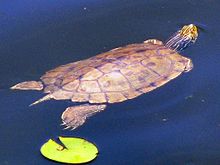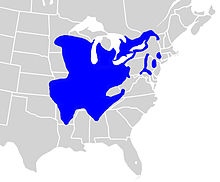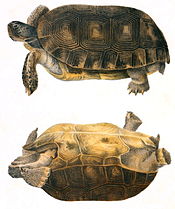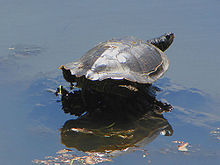- Northern map turtle
-
Northern map turtle 
Gatineau, Quebec Conservation status Scientific classification Kingdom: Animalia Phylum: Chordata Class: Reptilia Subclass: Anapsida Order: Testudines Family: Emydidae Subfamily: Deirochelyinae Genus: Graptemys Species: G. geographica Binomial name Graptemys geographica
(Le Sueur, 1817)
Range map The northern map turtle (Graptemys geographica), or formerly common map turtle,[1] is an aquatic turtle that belongs to the family Emydidae.
Contents
Description
The northern map turtle gets both its common and scientific names from the marking on the skin and carapace. The light markings resemble contour lines on a map or chart.[2] The lines on the carapace are shades of yellow, tan, or orange and are surrounded by dark borders. The rest of the carapace is olive or greyish brown. The carapace markings on older individuals tend to fade but are usually still apparent when the shell is wet. The carapace has a hydrodynamic appearance and is broad with a moderately low keel. The rear of the carapace is flared and the rear marginals form serrations. The plastron is yellowish and is marked by a central dark blotch (plastral figure) that follows the sutures of the plastral scutes and fades with age so that many adults lack a pattern all together (i.e., the plastron is immaculate). The head, neck and limbs are dark olive, brown, or black with thin yellow or green stripes. There is an oval or triangular spot located behind the eye. Like other map turtles, this species exhibits extreme sexual size dimorphism.[3] Males are 10–16 cm (3.9–6.3 in) in carapace length and weigh between 150–400 g (5.3–14 oz), while females are 18–27 cm (7.1–11 in) in carapace length and weigh around 0.5–2.5 kg (1.1–5.5 lb). Females have a much wider head than males and this is associated with differences in feeding.[3] Males have a narrower carapace with more distinct keel, narrower head, and a longer, thicker tail. Unlike females, the opening of the cloaca is beyond the rear edge of the carapace. Young map turtles have a pronounced dorsal keel. Hatchlings have a round grayish-brown carapace that is about 2.5 cm (0.98 in) long.
Variation
In early summer in southeast Michigan (according to a study done by R. Irwin) The Northern Map Turtle will display a reddish color in the most front part of their carapace. This was only seen in turtles ranging from 6–10 cm (2.4–3.9 in). The reason for this coloration is still unknown.
Distribution
Northern map turtles inhabit an area from south Quebec and Ontario to northern Vermont where it lives in the St. Lawrence River drainage basin. Its range extends west through the Great Lakes and into southern Wisconsin and eastern Minnesota, west of the Appalachians, south to Kansas, northwestern Georgia. It also occurs in the Susquehanna River system located in Pennsylvania and Maryland and also in the Delaware River.
Habitat
The northern map turtle inhabits ponds, rivers and lakes. They prefer large bodies of water and areas with fallen trees and other debris for basking. These turtles are more often found in rivers than in lakes or ponds. They are found in larger rivers and lakes in the northern portion of their range but are more likely to live in smaller rocky rivers and streams in the south and west.[3]
Ecology and behaviour
This turtle is dormant from approximately November through early April depending on local climactic factors. Northern map turtles spend the winter under water and do not surface to breathe, especially when ice cover makes this impossible. Adults rest on the bottom or wedged underneath rocks or logs and often hibernate communally with other northern map turtles where they may remain somewhat active.[2] Hibernacula must be well oxygenated because, unlike some other turtle species such as painted turtles, map turtles need to absorb oxygen from the water in order to survive the winter.[3] They are avid baskers and they bask in groups. They are diurnal. They are also a very wary animal; at the slightest hint of danger they slip into the water and hide.
Reproduction
Northern map turtles breed in the spring and fall. Most mating takes place in deep waters. The nesting period lasts from May to July. Unshaded sites with sandy soil is highly preferred. The female usually chooses well-drained areas for depositing the eggs. The nest cavity is dug with the hind feet. The size of the clutch is between 6 to 20. The eggs are oval and have a flexible shell that is about 3.2 cm. After the eggs are laid the cavity is filled. They hatch between 50 to 70 days of incubation and most emerge in August to September. When a nest hatches late, the northern map turtle has been known to overwinter in the nest. The female usually lays two or more clutches in one breeding season. The sexes of the young are determined by the temperature. At 25 degrees Celsius incubation produces a majority of males whereas 30–35 °C (86–95 °F) yields more females.
Diet
Map turtles are more carnivorous than most other members of the family Emydidae, and the northern map turtle is no exception. Adult females have wide heads and broad alveolar crushing surfaces in their mouths which they use to feed on molluscs, their primary prey, as well as insects and crayfish.[3] Adult males are much smaller and have narrower heads and feed on smaller molluscs and insects.[3] Like most other aquatic turtles, feeding always takes place in the water. In places where invasive molluscs such as Zebra mussels and Asian clams (Corbicula fluminea) are abundant they may become the most important food of female northern map turtles.[4][5]
Conservation status
Like most other turtle species, northern map turtles have probably declined but they remain widespread and may be abundant in some locations.[3] This species is has not been assessed by the IUCN. In Canada it is listed as a species of special concern.[6]
See also
References
- ^ Scientific and Standard English Names of Amphibians and Reptiles of North America, North of Mexico ..., SSARHERPS.org
- ^ a b : Status Report of the Northern Map Turtle Committee on the Status of Endangered Wildlife in Canada
- ^ a b c d e f g Ernst,C.H. and J.E. Lovich. (2009) "Turtles of the United States and Canada. 2nd Ed." Washington:Simsonian Institute Press. pg 293-302.
- ^ Lindeman, P.V. 2006. Zebra and quagga mussels (Dreissena spp.) and other prey of a Lake Erie population of common map turtles (Emydidae: Graptemys geographica). Copeia. 2006(2): 268-273.
- ^ Moll, D. 1980. Dirty River Turtles. Natural History. 89: 42-49.
- ^ Northern map turtle, Species At Risk Public Registry
- Conant, R.,J. Collins. 1998 Reptiles and Amphibians in the Eastern/Central North America. New York: Houghton Mifflin.
- Harding, J. 1997. Amphibians and Reptiles of the Great Lakes Region. Michigan: The University of Michigan Press.
- Map Turtle, Natural Resources Canada
- Northern Map Turtle, Adopt-a-Pond
Order Testudines (turtles) Suborder SuperfamilySubfamily
Cryptodira Chelydra · MacrochelysCaretta · Chelonia · Eretmochelys · Lepidochelys · NatatorDermochelysDermatemydidaeDermatemysStaurotypinaeClaudius · StaurotypusBatagur · Cuora · Cyclemys · Geoclemys · Geoemyda · Hardella · Heosemys · Leucocephalon · Malayemys · Mauremys · Melanochelys · Morenia · Notochelys · Orlitia · Pangshura · Rhinoclemmys · Sacalia · Siebenrockiella · VijayachelysAldabrachelys · Astrochelys · Chelonoidis · Chersina · Cylindraspis · Geochelone · Gopherus · Homopus · Indotestudo · Kinixys · Malacochersus · Manouria · Psammobates · Pyxis · Stigmochelys · TestudoTrionychiaCarettochelyidaeCarettochelysTrionychinaePleurodira ChelidinaeChelodininaeHydromedusinaePelomedusa · PelusiosPhylogenetic arrangement based on turtles of the world 2010 update: annotated checklist. Extinct turtles not included.
See also List of Testudines families
 Portal ·
Portal ·  WikiProject
WikiProjectGraptemys Species Alabama map turtle · Barbour's map turtle · Black-knobbed map turtle · Cagle's map turtle · Escambia map turtle · False map turtle · Northern map turtle · Ouachita map turtle · Pascagoula map turtle · Pearl river map turtle · Ringed map turtle · Texas map turtle · Yellow-blotched map turtleCategories:- IUCN Red List least concern species
- Graptemys
- Reptiles of North America
- Reptiles of Canada
- Fauna of Delaware and Maryland
- Reptiles of the United States
- Reptiles of Ontario
Wikimedia Foundation. 2010.





